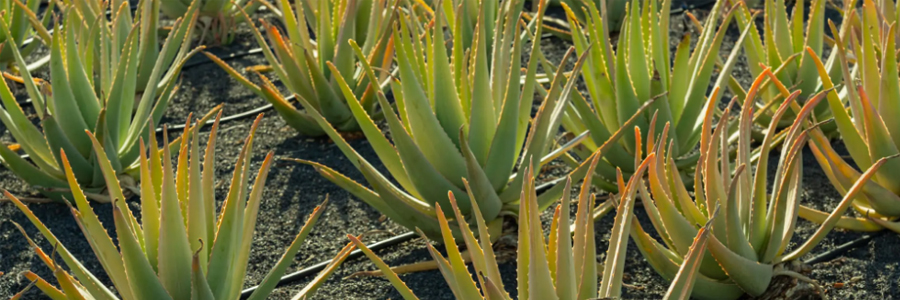Aloe
Taxonomic Classification
The Aloe genus belongs to the family Asphodelaceae. It is a large and diverse group, with over 500 recognized species of succulent plants. The name “Aloe” has ancient origins and has been used since at least the time of the ancient Egyptians. Native to Africa, Madagascar, and the Arabian Peninsula, Aloe species have adapted to a wide range of arid and semi – arid habitats.
Morphological Characteristics
1.Leaf Structure
Aloe plants are characterized by their thick, fleshy leaves that are arranged in a rosette pattern. The leaves are succulent, designed to store water, which is crucial for their survival in water – scarce environments. The leaf shape can vary from long and narrow, as seen in Aloe vera, to broad and lance – shaped, such as in Aloe arborescens. The leaf surfaces may be smooth, waxy, or covered in small white spots or bumps. The edges of the leaves are often serrated, with small, tooth – like projections, and some species may have spines along the edges or at the tip of the leaf.
2.Stem and Growth Habit
The stems of Aloe plants can be either short and inconspicuous, with the leaves emerging directly from the base of the plant, or in some species, they can be more elongated and woody, giving the plant a more tree – like appearance. Aloe arborescens, for example, can develop a trunk – like stem and grow up to several meters tall. Many Aloe species produce offsets, which are small plantlets that emerge from the base of the mother plant. These offsets can be easily separated and propagated to form new plants.
3.Flowering Characteristics
Aloe plants produce tall, erect flower stalks that emerge from the center of the rosette. The flower stalks can be simple or branched, and they are topped with clusters of tubular or bell – shaped flowers. The flower colors vary widely among species, including red, orange, yellow, and pink. Aloe ferox, for instance, produces large, bright red flower spikes. The flowers are often attractive to pollinators such as birds, bees, and butterflies. The flowering period usually occurs in winter or spring, but it can vary depending on the species and the local climate.
Common Varieties
1.Aloe vera
Aloe vera is one of the most well – known Aloe species. It has thick, fleshy, green leaves with white spots when young. The leaves are arranged in a rosette pattern and have small, serrated edges. Aloe vera is widely used for its medicinal properties, with the gel inside the leaves being used in various skincare products, remedies for burns, and digestive aids. It produces tall flower stalks with yellow flowers in spring or summer.
2.Aloe arborescens
Also known as the Krantz aloe, Aloe arborescens has long, lance – shaped leaves that are arranged in a rosette at the end of a woody stem. The leaves are green and have small, brown – tipped spines along the edges. It can grow up to 3 – 6 meters tall in its natural habitat. The plant produces large, orange – red flower spikes in winter, which are very attractive. It is a popular ornamental plant and is also used in some traditional medicine.
3.Aloe ferox
Aloe ferox is a large – growing Aloe species. It has thick, broad leaves that are covered in small white spots. The leaves are arranged in a rosette and have sharp, brown spines along the edges. It produces tall, bright red flower spikes that can reach up to 2 meters in height. Aloe ferox is native to southern Africa and is known for its medicinal properties, with its sap being used in traditional medicine and in the production of some commercial products.
4.Aloe polyphylla
Also called the Spiral aloe, Aloe polyphylla is a unique – looking species. It has thick, triangular – shaped leaves that are arranged in a spiral pattern, forming a beautiful, symmetrical rosette. The leaves are green with white edges and small spines. It is a slow – growing plant and is native to the mountains of Lesotho. It produces tall flower stalks with pink – red flowers in summer.
5.Aloe vera var. chinensis
This variety of Aloe vera has similar characteristics to the standard Aloe vera but may have some minor differences in leaf shape and growth habit. The leaves are thick and fleshy, and it also has the well – known gel – filled interior. It is often used in traditional Chinese medicine and is a popular houseplant. It produces yellow flowers on tall stalks during the appropriate growing season.


